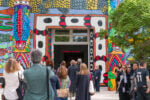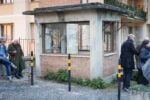Lina Selander
.jpg)
La mostra prevede tre installazioni video realizzate tra il 2011 ed il 2014, che sono parte del più ampio progetto intitolato Excavation of the Image: Imprint, shadow, spectre, thought, con il quale Lina Selander rappresenta la Svezia alla 56. Biennale di Venezia.
Comunicato stampa
La galleria Tiziana Di Caro è lieta di presentare la prima personale dell'artista svedese Lina Selander (Stoccolma, 1973), che inaugura giovedì 11 giugno 2015 alle ore 19:00, in Piazzetta Nilo 7, Napoli.
La mostra prevede tre installazioni video realizzate tra il 2011 ed il 2014, che sono parte del più ampio progetto intitolato Excavation of the Image: Imprint, shadow, spectre, thought, con il quale Lina Selander rappresenta la Svezia alla 56. Biennale di Venezia.
Storia, politica, economia e memoria sono alcuni dei temi trattati da Lina Selander nelle sue opere, installazioni e video organizzati ritmicamente attraverso meta – montaggi in cui allo scorrere di immagini fisse si alternano video e film di repertorio, nonché riprese di volta in volta inedite, creando relazioni tematiche tra immagine e linguaggio, fotografia e film. La mostra si apre con Model of Continuation (2013), opera che ben incarna l'idea dell'artista secondo cui "le immagini appartengono alla tecnologia che le ha generate". È un lavoro sull'"immagine" in quanto oggetto, struttura di contemplazione. Si sviluppa in un interno, un ambiente nel quale si vede scorrere un altro video; si tratta quindi di un'immagine nell'immagine, e del rapporto che quest'ultima ha con la tecnologia della riproduzione.
Un'altra sala ospita il progetto Lenin's Lamp Glows in the Peasant's Hut (2011) il cui titolo è preso in prestito dal film di Dziga Vertov L'Undicesimo, a cui il video di Selander è strettamente connesso. L'Undicesimo fu realizzato dal regista sovietico nel 1928 in occasione della celebrazione della Rivoluzione d'Ottobre. Vertov descrive la costruzione della centrale elettrica sul fiume Dnieper, che diventa il simbolo del progresso e dell'evoluzione operata dal regime; è quindi una celebrazione della potenza dell'Unione Sovietica attraverso le azioni legate allo sviluppo tecnologico. Allo stesso modo Lina Selander descrive Pripyat, città ucraina situata anche essa sul fiume Dnieper, che fu costruita per accogliere gli operai della centrale nucleare di Cernobyl, che furono poi vittime della stessa in seguito all'esplosione del 1986. A distanza di anni, quello stesso sviluppo tecnologico descritto da Vertov ha provocato uno dei più grandi disastri della storia dell'uomo. Oltre a prendere in prestito alcune scene del film del 1928, Selander ne cita alcuni passaggi come ad esempio la sequenza in cui i lavoratori sovietici si impegnano nella costruzione, manifestando entusiasmo e gioia, che nel video diventano operai di decontaminazione, ovvero coloro che furono spediti a scavare un tunnel sotto il reattore e che morirono poco dopo a causa delle radiazioni. Lenin's Lamp Glows in the Peasant's Hut è anche il titolo di una placca di acciaio che, collocata nello stesso ambiente del video, ne riflette le immagini mescolandole con una serie di parole e frasi chiave che sono alla base dell'intero progetto, che si completa con una vetrina che custodisce fotografie prodotte mettendo a contatto pietre contenenti l'uranio con la carta fotografica, e facendo emergere forme astratte che si comportano come radiografie (ed è così che le titola l'artista), mostrando l'invisibile, ovvero le radiazioni che i minerali hanno assorbito dal metallo.
L'ultima sala ospita The Offspring Resembles the Parent (2015), il lavoro realizzato in collaborazione con Oscar Mangione per il Padiglione svedese alla Biennale di Venezia. Si tratta di un video per immagini fisse che ha come oggetto l'influenza che l'economia esercita sulla società, quindi sulla storia. L'analisi avviene anche attraverso immagini di repertorio, tra cui riproduzioni di banconote relative alla grande inflazione tedesca degli anni Venti, le cui iconologie ed iconografie possono rivelare passaggi storici determinati, seppur reconditi.
Lina Selander costruisce ognuno dei suoi progetti espositivi servendosi di una precisa progettualità, ed i suoi schemi installativi riguardano lo spazio e le relazioni che con esso creano le sue opere. Il valore che Lina Selander dà al montaggio delle sue mostre fa sì che nel loro complesso siano esse stesse opere, di modo che l'atto della creazione diventi una costante senza fine.
Lina Selander ha esposto ad INIVA, Institute of International Visual Arts, London (2015), alla Konsthall di Örebro, Örebro (2014), al Kalmar Konstmuseum, Kalmar (2014), a La Mirage, Montréal, QC, Canada (2014), alla Kunsthall Trondheim, Trondheim (2014), all'OEI Colour Project, Stockholm (2013), al Bielefelder Kunstverein, Berlin (2012), all'INDEX -The Swedish Contemporary Art Foundation, Stockholm (2011), a Manifesta 9, The European Biennial of Contemporary Art, Belgium (2012), al Centre Georges Pompidou, Paris (2011) e in molte altre istituzioni.
Il suo lavoro è presente in varie collezioni pubbliche tra cui al Moderna Museet, Stockholm, EMS, Stockholm, Malmö, Konstmuseum, Bonniers Art Collection, Sveriges Allmänna Konstförening, National Museum, Stockholm, Deutsches Buch- und Schriftmuseum, Leipzig, Bibliothèque Nordique, Paris, Nationalmuseum, Stockholm, Örebro Municipality.
Lina Selander è l'artista che sta rappresentando la Svezia alla 56. Biennale d'arte, in corso a Venezia fino a novembre 2015.
La stessa presso la Galleria Alfonso Artiaco inaugura la personale di Ida Tursic & Wilfried Mille intitolata Pasta al nero di seppia.
Press Release
Artists: Lina Selander
exhibition opening: Thursday, 11 June 2015, from 7:00 p.m.
location: Galleria Tiziana Di Caro
address: Piazzetta Nilo, 7 – 80134, Naples
info: +39 081 552 5526- [email protected]
opening times: Monday to Friday 15:00 to 20:00, Saturday by appointment
exhibition closing: : Friday, September 4, 2015, at 20:00
Tiziana Di Caro art gallery is pleased to present the first solo exhibition of Swedish artist Lina Selander (Stockholm, 1973), opening Thursday, June 11, 2015 at 7:00 p.m., in Piazzetta Nilo 7, Naples.
The exhibition includes three video installations created between 2011 and 2014, which are part of a larger project entitled Excavation of the Image: Imprint, shadow, spectre, thought, with which Lina Selander is representing Sweden at the 56. Venice Biennale.
History, politics, economy and memory are some of the topics covered by Lina Selander in her works, installations and videos arranged rhythmically through meta-assemblages in which the flow of still images alternates with videos and film footage, as well as unreleased shots, creating thematic relationships between image and language, photography and film. The exhibition opens with Model of Continuation (2013), a work that aptly embodies the artist’s idea that “images belong to the technology with which they were created.” It is a work on the “image” as an object, a structure of contemplation. The work develops in an interior, an environment where another video is being shown, resulting in an image in another image, and the relationship that this has with the technology of reproduction.
Another room hosts the project Lenin’s Lamp Glows in the Peasant’s Hut (2011), whose title is borrowed from Dziga Vertov’s film The Eleventh Year, to which Selander’s video is strongly connected. The Eleventh Year was shot by the Soviet director in 1928 in connection with the celebration of the October Revolution. Vertov describes the building of the power station on the Dnieper River, which becomes the symbol of progress and development promoted by the regime; it is therefore a celebration of the power of the Soviet Union through the actions related to technological development. Similarly, Lina Selander describes Pripyat, a Ukrainian city also situated on the Dnieper River, which was built to accommodate the workers of the Chernobyl nuclear power plant, later to become the victims of the plant’s explosion in 1986. Years later, that same technological development described by Vertov caused one of the greatest disasters in human history. In addition to borrowing a few scenes, Selander also quotes certain passages from the 1928 film, such as the sequence in which the Soviet workers engage in building, showing enthusiasm and joy, and that in the video become decontamination workers, i.e. those who were sent to dig a tunnel under the reactor and who died shortly after due to radiation. Lenin’s Lamp Glows in the Peasant’s Hut is also the writing on a steel plaque which, placed in the same environment where the video is being shown, reflects its images mixing them with a series of words and key phrases that underlie the entire project, which is completed by a glass case displaying photographs produced by putting in contact uranium-contaminated stones with photographic paper that, much like in radiographs (hence the title given by the artist), bring out abstract shapes, thus showing the invisible, that is the radiations which the minerals absorbed from the metal.
The last room hosts The Offspring Resembles the Parent (2015), a work made in collaboration with Oscar Mangione, produced for the Swedish Pavilion on the occasion of the last Venice Biennale. The video is made of fixed images, whose focus is the influence economy exercises on society, therefore on history. The analysis is done through archive material, which includes also many old images of banknotes, whose iconology and iconography can reveal determinate historical passages, even if they seem hidden.
Lina Selander constructs each of her exhibition projects using a specific planning, and her installation diagrams focus on space and the relationships that this creates with her works. The value that Lina Selander gives to the setting up of her exhibitions results in these becoming themselves works, so that the act of creation becomes endless.
Lina Selander has exposed at INIVA, Institute of International Visual Arts, London (2015); Konsthall in Örebro, Örebro (2014); Kalmar Konstmuseum, Kalmar (2014); La Mirage, Montréal, QC, Canada (2014); Kunsthall Trondheim, Trondheim (2014); OEI Colour Project, Stockholm (2013); Bielefelder Kunstverein, Berlin (2012); INDEX - The Swedish Contemporary Art Foundation, Stockholm (2011); Manifesta 9, The European Biennial of Contemporary Art, Belgium (2012); Centre Georges Pompidou, Paris (2011), and in many other institutions.
Her work is in several public collections including the Moderna Museet, Stockholm, EMS, Stockholm, Malmö, Konstmuseum, Bonniers Art Collection, Sveriges Allmänna Konstförening, National Museum, Stockholm, Deutsches Buch- und Schriftmuseum, Leipzig, Bibliothèque Nordique, Paris, Nationalmuseum, Stockholm, Örebro Municipality.
Lina Selander is the artist who is representing Sweden at 56. Biennale in Venice, ongoing until November 2015.
The same night at Galleria Alfonso Artiaco it will open Ida Tursic & Wilfried Mille' solo show, entitled Pasta al nero di seppia.



